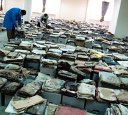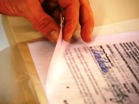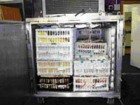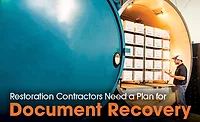Fast Action Required to Restore Water-Damaged Documents
Coping with repairs or replacement of equipment and furnishings seriously damaged by water filtration or flooding is challenging enough for owners and managers of commercial businesses and offices.

Coping with repairs or replacement of equipment and furnishings seriously damaged by water filtration or flooding is challenging enough for owners and managers of commercial businesses and offices. Yet, many overlook one of the greatest consequences – the potentially irreparable damage to documents.
Whether the documents are paper, books, files, medical records, electronic media or legal documents, any delay in the decision to dry the materials can result in permanent loss. Inks can break down, making the text illegible. Dirt and grime can penetrate the paper and pages can adhere. Mold and mildew will grow quickly on water-soaked documents.
That’s why the key to a successful recovery of these materials is rapid response time. And, this response should be handled by a document restoration specialist.
An experienced provider will rapidly identify the best recovery method for a particular material, based on the value of the documents and the level of damage. For example, in the right circumstances, freezing documents can drastically reduce the time and cost of restoration. It also prevents the need for mold remediation, page separation and other, more expensive, corrective procedures.
Consider partnering with a provider that can assist in the clean-up of the disaster area and stabilize the indoor environment to reduce the moisture load to prevent the spoiling of unaffected documents.
Following are the key phases of a document restoration project and the steps involved for a successful recovery.
The Recovery Process
The recovery process requires the technical expertise and equipment of a proven service provider. It’s important that this restoration company is up-to-date with the most advanced techniques available, such as vacuum freeze drying, blast freezing, microbial disinfecting, deodorization, soot removal, and more.
The recovery process to dry and clean documents begins with two initial steps:
- Freezing. In order to halt deterioration, it is essential that documents be frozen as soon as possible. Usually, freezer-equipped truck trailers or freezer warehouses are used for this stage. The frozen materials can be stored until the professional drying procedure begins.
- Inventory and Sorting. While the documents are frozen, decisions can be made regarding which to dry and clean and which to discard; work can begin to prune unwanted materials. Loose documents and files stored in cabinets are packed into boxes, labeled to identify contents.

The Drying Procedure
The second phase is the drying of the materials. Depending upon the type and extent of damage, and the materials, different treatments may be recommended. There are two primary methods used to dry documents – vacuum freeze-drying and desiccant drying.
Vacuum Freeze-Drying
A freeze drying process is the most efficient and effective method for the drying of wet papers and other documents. Using accelerated vacuum freeze dry systems, Polygon technicians can restore water-damaged materials quickly and effectively, reducing back processing time by 20 to 30 percent compared to similar systems.
During this process, the materials are placed in an airtight chamber into which negative vacuum pressure is induced. As a function of physics, moisture in the documents turns into a gaseous state. The “gas” is expelled from the chamber, where it is condensed into liquid, which is then aborted. As a result, the documents go from the frozen state to being dry without ever becoming re-liquefied.
This method is especially beneficial in cases where documents may warp or distort. After drying, materials will have a smoother appearance than is generally achieved via slower, less efficient freeze drying methods.
Desiccant Drying
In this process, the frozen documents are removed from the packing cases and placed on racks and shelves in a large, vault-like 6,000 square-foot room. Applying desiccant dehumidification, the room atmosphere is maintained at about 68ºF and 12% humidity.
Desiccants attract moisture molecules directly from the air and release them into an exhaust air stream. Desiccants can attract and hold from 10 to more than 10,000 percent of their dry weight in water vapor. The essential characteristic of desiccants is low surface vapor pressure. A cool, dry desiccant can attract moisture from the air because its surface vapor pressure is low. When the desiccant becomes wet and hot, creating high surface vapor pressure, it will give off vapor to the surrounding air. Vapor moves from the air to the desiccant and back again depending on the vapor pressure differences.
Desiccant dehumidifiers use the changing vapor pressures to dry air continuously in a repeating cycle. In so doing, the continually moving dry air created in the drying room removes the moisture from the documents. Depending on the amount of moisture and documents being dried, the process can take from one to seven days to complete.
Cleaning
After drying, the documents are cleaned and then placed into new boxes, re-labeled according to the inventory and returned to the owner.
Cleaning removes any dirt or grime and, more importantly, fungi spores. Trained staff clean each document using materials such as sponges and scrub pads, while avoiding the application of liquid solutions that would reactivate the moisture in the materials. In cases when they deal with mold spores, individuals wear personal protection equipment and follow standard procedures for spore removal, including the use of High Efficiency Particulate Arrestor (HEPA) vacuum systems.
Cleaning also is accomplished on non-paper materials that are not first dried, such as film, microfiche, x-rays and audio and videotape.
All of this work requires the provider to offer properly trained cleaning and restoration technicians and management staff oversee your recovery projects. Some providers will use temporary labor while others utilize seasoned professionals that typically have five to 10 years experience.
Offering the necessary technology also is important. A qualified document center should offer blast freezing, which freezes quickly and kills bacteria; stabilization or capacity to freeze documents to mitigate damage; cleaning; desiccant air drying; vacuum freeze drying; and secure document storage.

On-Site Drying Option
In some cases, disaster-affected entities require that documents be dried at the site. Confidential files, information needed on a regular basis or legal requirements all may dictate that situation. In such cases, an on-site drying facility is established.
In this case, standing water is removed and damaged documents packed and placed in a nearby freezer warehouse or refrigerated trailers. The goal is to use the fastest methods to make critical documents usable and to save as many others as possible.
A provider may establish a processing center nearby in a rented building a short distance from the freezer warehouse. This space must be prepared by sealing air leaks and creating a climate controlled environment via portable industrial desiccant dehumidifiers.
This processing center will include a thawing room, where frozen documents are identified, categorized, labeled and logged into a computerized inventory control system. It also should include a second area where moisture is removed from the documents in a drying chamber.
At the same time, non-paper items, including x-rays and computer disks, which are not suitable to the freeze-drying process, are salvaged through desiccant drying.

Preparation is Key
The best insurance against catastrophic loss of vital documents is to be prepared in advance of a disaster. Having a written Disaster Recovery Plan (DRP) can limit the extent of damage by defining and prioritizing the recovery steps. Including a document recovery section in the overall DRP will detail essential steps and include contact sources for recovery.
Looking for a reprint of this article?
From high-res PDFs to custom plaques, order your copy today!




